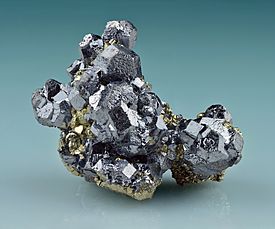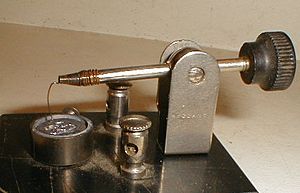Galena facts for kids
Quick facts for kids Galena |
|
|---|---|

Galena with minor pyrite
|
|
| General | |
| Category | Sulfide mineral |
| Formula (repeating unit) |
PbS |
| Strunz classification | 2.CD.10 |
| Dana classification | 2.8.1.1 |
| Crystal symmetry | Fm3m |
| Unit cell | a = 5.936 Å; Z = 4 |
| Identification | |
| Color | Lead gray and silvery |
| Crystal habit | Cubes and octahedra, blocky, tabular and sometimes skeletal crystals |
| Crystal system | Cubic |
| Twinning | Contact, penetration and lamellar |
| Cleavage | Cubic perfect on {001}, parting on {111} |
| Fracture | Subconchoidal |
| Tenacity | Brittle |
| Mohs scale hardness | 2.5–2.75 |
| Luster | Metallic on cleavage planes |
| Streak | Lead gray |
| Diaphaneity | Opaque |
| Specific gravity | 7.2–7.6 |
| Optical properties | Isotropic and opaque |
| Fusibility | 2 |
| Other characteristics | Natural semiconductor |
Galena, also known as lead glance, is a natural mineral. It is the most common form of lead(II) sulfide (PbS). Galena is the main source of lead and an important source of silver.
It is one of the most common sulfide minerals found around the world. Galena forms in a cubic shape, often looking like octahedrons. You can often find it with other minerals like sphalerite, calcite, and fluorite.
Contents
Where Galena is Found
Galena is the main source of lead. People have used lead from galena since ancient times. It was easy to get the lead out by melting the galena in a simple wood fire.
You usually find galena in hydrothermal veins. These are cracks in rocks where hot, mineral-rich water once flowed. It often appears with minerals like sphalerite, marcasite, chalcopyrite, cerussite, anglesite, dolomite, calcite, quartz, barite, and fluorite.
You can also find galena in lead-zinc deposits. These are often found in limestone beds. Smaller amounts are in areas changed by heat and pressure, in pegmatites, and spread out in sedimentary rocks.
Galena with Silver
Some galena deposits contain up to 0.5% silver. This silver can be worth much more than the lead itself! In these places, silver is found as tiny bits of silver sulfide minerals. It can also be mixed into the galena structure.
These silver-rich galenas, called argentiferous galenas, have been a key source of silver for a long time. Silver-bearing galena usually forms from hot water. Galena found in regular lead-zinc deposits usually has very little silver.
Major Galena Locations
Galena deposits are found all over the world. Important places include:
- Freiberg in Saxony, Germany
- Cornwall, the Mendip Hills in Somerset, Derbyshire, and Cumberland in England
- The Madan and Rhodope Mountains in Bulgaria
- The Sullivan Mine in British Columbia, Canada
- Broken Hill and Mount Isa in Australia
- The old mines of Sardinia, Italy
In the United States, galena is found in large amounts in the Lead Belt of southeastern Missouri. This is the biggest known deposit. It's also found in the Driftless Area of Illinois, Iowa, and Wisconsin. Galena was also a major mineral in the zinc-lead mines of the tri-state district around Joplin in Missouri, Kansas, and Oklahoma.
It's also an important mineral in silver mining areas of Colorado, Idaho, Utah, and Montana. The Coeur d'Alene district in northern Idaho was especially famous for it.
Australia was the world's top producer of lead in 2021. Most of this lead comes from galena. Silver-rich galena was found by accident at Glen Osmond in 1841. More deposits were found near Broken Hill in 1876 and at Mount Isa in 1923. Most Australian galena is found in deposits that formed about 1.68 billion years ago. These areas have since been greatly changed by heat and pressure.
The biggest galena crystal ever recorded was a group of cubo-octahedrons. It was found at the Great Laxey Mine on the Isle of Man. It measured about 25 by 25 by 25 centimeters (10 by 10 by 10 inches).
Why Galena is Important
Galena is the official state mineral for Kansas, Missouri, and Wisconsin. The towns of Galena, Kansas, and Galena, Illinois, are named after the large deposits of this mineral found there.
How Galena is Used
One of the oldest uses for galena was in eye makeup called kohl. In Ancient Egypt, people put kohl around their eyes. This helped reduce the bright glare of the desert sun. It also helped keep flies away, which could spread diseases.
In pre-Columbian North America, indigenous peoples used galena. They used it as an ingredient in decorative paints and cosmetics. It was traded widely across the eastern United States. Traces of galena are often found at the Mississippian city of Kincaid Mounds in Illinois. The galena used there came from deposits in Missouri and the Upper Mississippi Valley.
Galena is the main source of lead. It is also often mined for its silver content. It is used to make lead for ceramic glazes.
Galena is a semiconductor. This means it can conduct electricity under certain conditions. It has a small band gap of about 0.4 eV. This property made it useful in early wireless communication systems. It was used as the "crystal" in crystal radio receivers. Here, it acted as a point-contact diode. This allowed it to change alternating current into direct current to find radio signals. A sharp wire, called a "cat's whisker", touched the galena crystal to make it work.
See also
 In Spanish: Galena para niños
In Spanish: Galena para niños



